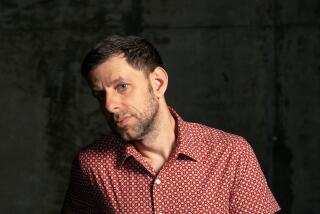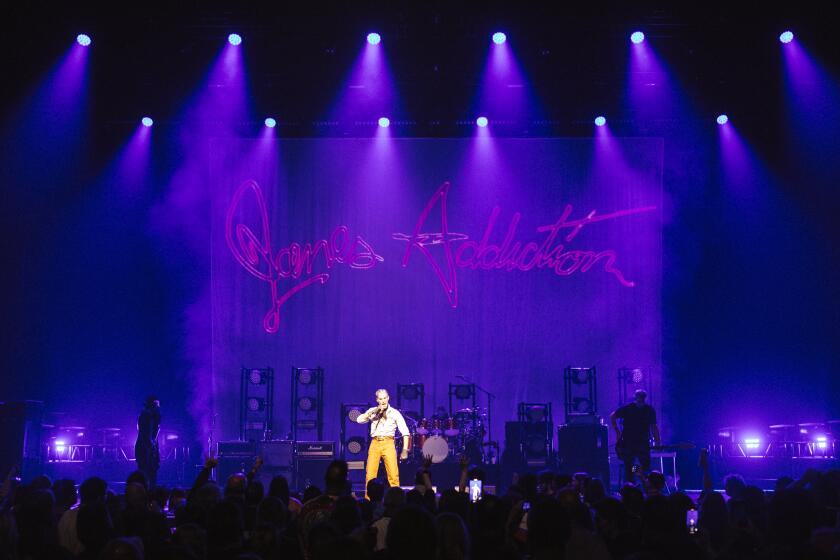Los Angeles Opera faces a modern-day dilemma
The first time the word “Regietheater” appeared in these pages was in 1985. The German term, which means “director’s theater,” was described a year later by a Times critic as a trend that “consigned the ‘outdated’ wishes of composer and librettist to a stupid oblivion.”
Twenty-five years later, “Regietheater” is no longer just a German trend but a significant part of operatic life in America — especially on the West Coast. When Los Angeles Opera presents the company premiere of Gioacchino Rossini’s “The Turk in Italy” on Saturday, it will not be seen in costumes or sets reflecting the period in which the opera was originally set (18th century) or written (19th century) but rather in contemporary dress, complete with espresso machines and televisions. Does director Christof Loy’s mid-20th century update of an opera buffa from 1814 go against the wishes of the creators or is it simply a way to view an old work with new eyes?
This is a question that often divides the opera world — and creates headaches for opera administrators. Making things more difficult, says Christopher Koelsch, L.A. Opera’s chief operating officer, are the terms used to describe productions, such as “modern” or “traditional,” which can be misleading.
“Any new production is going to reflect modern mores,” he says. “It’s unavoidable. Even a detailed period set of the Elizabethan era that was designed in the 1960s will ultimately say more about the ‘60s than the late 16th century,” he says.
This season at L.A. Opera, the only work to see a mostly “naturalistic” staging was the fall staging of its newest opera, the world premiere of “Il Postino.” Even the Metropolitan Opera, long considered one of opera’s most conservative houses, is seeing old, period stagings replaced with modern, more interpretive versions of the classics. The result is that booing, once a rarity at American houses (and almost never heard at the Dorothy Chandler Pavilion), has in recent years become almost expected when a director steps on stage for his or her bows on opening night.
Peter Gelb, the Met’s general manager, has witnessed a number of these opening nights and he admits: “Yes, there are segments of the audience that wants to see no new productions.” But he is adamant that opera must be always pushing forward. “Just as movie studios rely on what they call ‘tentpole events,’ new opera productions provide the excitement, the buzz for a whole season,” he says. “A new production is what gets the juices flowing.”
A generation after “Regietheater” arrived in America, why are audiences still shocked when a classic is given a new spin? Ian Campbell, one of the longest-serving opera administrators in the country (he’s been San Diego Opera’s general manager since 1983) says that one of the problems is, of course, money: “We’ve locked audiences into a kind of canon, because we keep repeating productions — they’re just too expensive to use and then just throw away.” He says this tradition made fiscal sense, “but American audiences got used to revivals of massive sets, in part thanks to the Met, and now many people still go to the opera to hear with their eyes.”
Campbell also stresses that unlike in Europe, where opera has been a tradition for hundreds of years, it’s still relatively new on the West Coast.
“When we did ‘Maria Stuarda,’ it was a traditional set and went over well in San Diego,” he recalls, “but I saw a production in Berlin that interpreted it as ‘What Ever Happened to Baby Jane?’ It worked, but we didn’t bring it here because you had to know the original to really know what was going on. Since we don’t have a lot of opera here, audiences don’t get a chance to know them as well.”
This is a problem L.A. Opera faced with last season’s “Ring” cycle. Many people complained that for their first time seeing Wagner’s epic, they wanted it to be more realistic. “L.A.’s ‘Ring’ made as many enemies as fans,” Campbell says.
Koelsch admits that Achim Freyer’s “Ring” caused controversy, but argues that it was very faithful to Wagner’s libretto. “Whereas our ‘Roméo et Juliette’ [first seen in 2005] is set in Victorian era, which is not when the source material is set,” he notes, “but there weren’t complaints.... Where is the tipping point?” (That Ian Judge production is being revived by L.A. Opera next season.)
This year the Met is in the midst of presenting its own new, more modern “Ring” (directed by Canadian Robert Lepage) and Gelb admits, “It’s an obstacle: the fear of what some in our audience refer to as ‘Eurotrash.’”
One of the frequent accusations audiences make against so-called “Eurotrash” — often attached to avant-garde production — is that they’re a waste of money. Unlike Los Angeles, which never had a “Ring” cycle, Met audiences have for 25 years enjoyed the very realistic Otto Schenk production. After one installment (which had technical problems and received mixed reviews) many Wagner fans asked: Why spend the money for something new when we already have a production we like?
Elaine Padmore, director of Opera for London’s Royal Opera (which is premiering Mark-Anthony Turnage’s opera about tabloid queen Anna Nicole Smith later this week), says the risk of new productions is worth it. “Obviously, everybody’s feeling the economic pinch and has to make some adjustments,” she says, “but we can’t be curators. Opera is a living art form. Yes, there is a great trade in existing masterpieces, but we also have to have that sparkle of the new.”
Koelsch makes the case that recycling old production isn’t always cost effective. “The bulk of expenses are for time and people, not sets and materials,” he explains, “Even if we were to costume next season’s ‘Simon Boccanegra’ at the Gap, it wouldn’t strictly be true to say that it would be cheaper.”
Gelb goes further and argues that new productions, even if they alienate some, are a sound investment: “You can decide to do no new productions to cut expenses, but the result is you will lose audiences.” Padmore agrees: “You run out of people who want to see the same productions over and over again, you have to have classic productions — the crown jewels you want to bring back — but you can’t flood the market for it.” Adds Gelb: “The alternative is you can take the risk of doing something new and find a new audience and new donors.”
The word “risk” is the key. All new productions are risks, and all three administrators admit that if they choose the wrong concept or director, the price is steep. Says Padmore, “With any bold, new production, there will be people who love it — and there will be people who want the old one … and if it falls flat on its face, despite all the expectations, you have to accept that that happens and you may very well have to cut your losses.”
Loy’s staging of Rossini’s “The Turk in Italy” is a proven success in Europe and he is an in-demand director there (he has twice been voted director of the year by Germany’s “Opernwelt” magazine, and the DVD of his recent production of “Lulu” was just nominated for a Grammy award). But this is Loy’s first production to be presented in the U.S.
The good news for L.A. Opera, says Campbell, is that “Turk” is a comedy and “Comedies are easier … you can do a lot with comedies and not get complaints. When we set ‘Don Pasquale’ in the Wild West, people were OK with that. When you do it with beloved, classic dramas like ‘Tosca,’ people tend to get upset.”
On Saturday night, Loy will not be present, but his collaborator, Axel Weidauer, the stage director for this run, will be in the house to face the crowd. He’s worked on this production in previous incarnations and doesn’t think it will be as divisive as, say, Freyer’s “Ring.”
Still, it will be called “modern” or “daring” by those who like it and Eurotrash by those who don’t. But even as segments of the audience howl (Heather MacDonald’s much forwarded 2007 article on https://www.city-journal.org, “The Abduction of Opera,” threatened one European director to “keep his grubby mitts off Mozart and write his own damn opera”) or stay away (i.e. L.A. Opera’s poorly attended World War I-set “Lohengrin” last fall), Regietheater isn’t going away.
Next fall, L.A. Opera opens the season with an imported, postmodern production of “Eugene Onegin” from Padmore’s Royal Opera. At the Met, Gelb insists he will continue to bring works by new directors, such as Richard Eyre’s “Carmen,” which in 2010 replaced a traditional Franco Zeffirelli production and updated the action to Franco’s Spain. The simple truth is that something new, even if it’s controversial, sells tickets, he says: “New productions this season are averaging 92% capacity, and revivals are running considerably less.”
L.A. Opera’s Koelsch concurs. “Some of our bestselling productions have been what could be called ‘nontraditional,’” he says, citing Freyer’s “Damnation of Faust” in 2003. “On the other hand, Achim’s ‘Mass in B-minor’ prompted shouting matches in the parking lot each night,” he says. “We couldn’t predict either result — the important thing is that both prompted an emotional response.”
In some way, the complaints of traditionalists, whether it’s their booing at curtain calls or rants in the opera blogosphere, only gives questionable productions more attention. “Remember,” Padmore says, “throughout operatic history, the things that we see as period costume stories were once scandalous modern dress affairs.”
“We’re not insensitive to our patrons,” Koelsh says, adding that opera tends to evoke great zeal. “A production that prompts both passion and ire? I’m fine with that.” Call it Regietheater or Eurotrash, the main goal of these productions, however lofty, trashy or misguided, appears to be grabbing hold of and keeping people’s attention.
“Even in Germany,” says Weidauer, the man who will face the cheers or boos when the music stops on Saturday night, “the only rule in the theater is never bore the audience.”
More to Read
The biggest entertainment stories
Get our big stories about Hollywood, film, television, music, arts, culture and more right in your inbox as soon as they publish.
You may occasionally receive promotional content from the Los Angeles Times.










